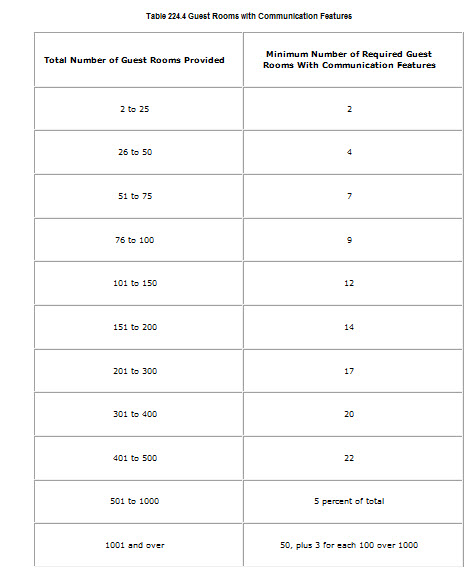When hotels “leave the light on for you”
Posted on - Sunday, March 13th, 2011The 2010 Accessibility Standards modified the provisions for transient lodging. The changes did not only occur in the technical standards, but also in the Department of Justice requirements for hotels and other transient lodging facilities.
The Department of Justice made the following additions to the 2004 ADAAG regarding transient lodging:
(1) Facilities that are subject to the same permit application on a common site that each have 50 or fewer guest rooms may be combined for the purposes of determining the required number of accessible rooms and type of accessible bathing facility
(2) Facilities with more than 50 guest rooms shall be treated separately for the purposes of determining the required number of accessible rooms and type of accessible bathing facility
(3) Alterations to guest rooms in places of lodging that are condos and not owned by the facility owner are not required to comply
• Housing at a place of education.
Housing at a place of education are considered transient lodging. The term “sleeping room” is intended to be used interchangeably with the term “guest room”. This also includes kitchens within housing units with multiple rooms. Some exceptions are:
o Apartments or townhouse facilities that are provided by or on behalf of a place of education, which are leased on a year-round basis exclusively to graduate students or faculty, and do not contain any public use or common use areas available for educational programming, are not subject to the transient lodging standards
• Social service center establishments.
Group homes, halfway houses, shelters, or similar social service center establishments that provide either temporary sleeping accommodations or residential dwelling units shall comply.
(1) In sleeping rooms with more than 25 beds covered by this part, a minimum of 5% of the beds shall have clear floor space
(2) Facilities with more than 50 beds that provide common use bathing facilities shall provide at least one roll-in shower with a seat. Transfer-type showers are not permitted in lieu of a roll-in shower with a seat. When separate shower facilities are provided for men and for women, at least one roll-in shower shall be provided for each group.
• Reservations Made by Places of Lodging.
o procedures that will allow individuals with disabilities to make reservations for accessible guest rooms during the same hours and in the same manner as other guests,
o and requirements that will require places of lodging to identify and describe accessible features of a guest room,
o to hold back the accessible guest rooms for people with disabilities until all other guest rooms of that type have been rented,
o and to ensure that a reserved accessible guest room is removed from all reservations systems so that it is not inadvertently released to someone other than the person who reserved the accessible room.
• Timeshares, Condominium Hotels, and Other Places of Lodging. The rule provides that timeshare and condominium properties that operate like hotels are subject to new Standards. If the condo is owned by a private person and not the operator of the place of lodging, then it is exempted.
Changes to the Technical Requirements for Transient Lodging
In the 2010 Standards, the section specific to Transient Lodging are 224 for scoping and 806 for the technical requirements. Below are a few of the changes to the technical requirements.
206.5.3 Transient Lodging Facilities. In transient lodging facilities, entrances, doors, and doorways providing user passage into and within guest rooms that are not required to provide mobility features complying with 806.2 shall comply with 404.2.3.
Advisory 224.1 General. Certain facilities used for transient lodging, including time shares, dormitories, and town homes may be covered by both these requirements and the Fair Housing Amendments Act. The Fair Housing Amendments Act requires that certain residential structures having four or more multi-family dwelling units, regardless of whether they are privately owned or federally assisted, include certain features of accessible and adaptable design according to guidelines established by the U.S. Department of Housing and Urban Development (HUD). This law and the appropriate regulations should be consulted before proceeding with the design and construction of residential housing.
806.2.1 Living and Dining Areas. Living and dining areas shall be accessible.
Remember that March 15, 2011 is when the new Standards become effective. They will be mandatory on March 15, 2012.
If you want to learn more about the new Standards, The ADA Companion Guide has the 2004 Guidelines with commentary and explanations throughout.
 Abadi
Abadi 


